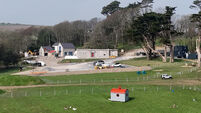‘Encouraging lead’ in search for missing plane

Angus Houston, the Australian head of the mission, said a second “ping” was also being scrutinised 300 nautical miles away in the Indian Ocean, as the one-month lifespan of batteries powering the beacons loomed.
The Malaysia Airlines Boeing 777 with 239 people aboard vanished on March 8 during a flight from Kuala Lumpur to Beijing.














